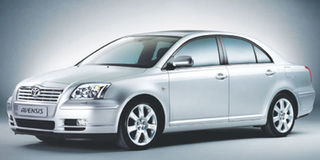The Avensis is just another bland Toyota

It is hard to come up with legitimate demerits without resorting to nit-picking, but it is also equally hard to come up with strong points that separate it from its equals.
What you need to know:
- The performance of this car is not exciting, maintenance is typical of pseudo-executive Toyota saloons and, being a Toyota, it is hard to come up with legitimate demerits without resorting to nit-picking
- Also, being a Toyota from the early 21st century, it is hard to come up with particular strong points that stand out versus other vehicles
- In other words, it is just another bland Toyota that will do everything a family saloon is supposed to
Hi Baraza,
I have shipped in a Toyota Avensis from the UK and have been told of certain concerns regarding the car:
1. That parts are not locally available; I will have to get some spares, such as suspensions and ball joints, from Dubai.
2. That body parts can only be found upon placing a special order to the auto spares dealer shops along Kirinyaga Road. Are these concerns real?
Also, please comment on the performance, maintenance, as well as the merits and demerits. It is a 1.8-litre automatic model.
John
1. Visit Toyota Kenya and ask if they have the parts you seek. They sold the car under franchise, they should be able to offer support for that model.
2. I repeat, visit Toyota Kenya and ask.
The performance of this car is not exciting, maintenance is typical of pseudo-executive Toyota saloons and, being a Toyota, it is hard to come up with legitimate demerits without resorting to nit-picking.
Also, being a Toyota from the early 21st century, it is hard to come up with particular strong points that stand out versus other vehicles (maybe fuel economy in the D4-D diesel version).
In other words, it is just another bland Toyota that will do everything a family saloon is supposed to. That is why I have never reviewed it; there is nothing to say without boring the hell out of my readers.
**************
Hi Baraza,
What is the difference between a restricted and unrestricted exhaust system in a car and how do the systems affect performance and fuel consumption?
Also, what are the pros and cons of low-profile tyres? Do they make a car more stable as compared to the “normal” tyres?
Restricted exhausts are what you would find in any normal car, complete with catalytic converters, back boxes, silencers and such.
Unrestricted exhausts have all these removed and are just one straight pipe from manifold to tip (hence the name straight-thru exhaust), which, more often than not, is of a larger diameter than stock (factory spec).
The effect is to improve performance, but you will not make your car faster by removing the silencer and the cat, you also have to map the ECU, in effect telling the engine that there is lower back pressure as compared to before, so adjust your timing accordingly.
Also, the real purpose of straight-thru exhaust comes after engine modifications are done; such modifications will make the engine rev higher, faster and with greater volume/mass of intake charge/exhaust products, such as by forced induction or using bigger and highly polished intakes.
The exhaust is rarely, if ever, Step 1 in making a car go faster.
About low-profile tyres; Pros: better handling since most low-profile tyres are also wide-section and offer better grip. Also, the thinner side walls are stiffer and so reduce body roll and the tendency to flip over.
Cons: They are expensive, and they make the car uncomfortable. They also are unsuitable for less-than-perfect road conditions as the impact from constant bumping makes them swell.
**************
JM,
What would be your advice in regard to driving on roads that have been damaged by heavy trailers such as the section near Eldoret?
Is there any damage to the wheels/suspension if one drives on the raised “rails” now that this seems to be the only way out for low cars (else their under-carriage will scrape the road)?
I know the place you are referring to: not too far from the Equator crossing and just next to the turn-off into Kapsabet, right?
The trick is to keep the tyres on either side of the car on top of the bumps (or “rails” as you call them).
Avoid slipping into the troughs as you might bend your steering arms, scrape off the sump or even knock out the diff in a rear-drive car if it is low enough. Keep your speed low to guarantee control and avoid skidding under hard braking (downhill plus slippery road surface).
**************
Baraza,
I previously owned a Toyota 110 but recently disposed of it. I now want to buy another car and, owing to the market prices, I have decided to go for a Subaru Impreza.
I would like to know the consumption of this car verses Toyotas of the same engine capacity (1500cc) and why people don’t like Subarus as much as they do Toyotas.
Njoroge.
The fuel economy figures for Subarus and Toyotas should not be too disparate, if we keep turbos out of the picture.
The Subs may be a touch thirstier owing to the AWD transmission, but this is not something you cannot recover with a little common sense.
After all, Subarus are built and developed by Toyota (in a way).
The disregard for Subaru cars stems from several avenues.
First, are the turbocharged versions; they are thirsty, especially when pushed, so people generally assume (after buying the wrong Subaru once) that all Subs are dipsomaniacs.
Second, is the STi clique, the Impreza WRX fan club.
While not all of them exhibit anti-social behaviour on the roads, there are one or two bad cards that will overtake you while driving on the pavement or wake you up at 3am as they pass outside your bedroom window in a car equipped with an aftermarket exhaust system and ALS (anti-lag system), sounding like a small army is invading your neighbourhood with automatic weapons.
But they are not all evil, sleep-depriving, rule-flouting louts in the STi club. Just as not all Subarus are turbocharged, and so not all will deplete your disposable income. Feel free to get an Impreza, even an STi if you are up to the task, but please don’t drive like an idiot.
**************
JM,
My friend and I are re-engineering the petrol engine of a saloon car so that it uses hydrogen; don’t be bewildered, great inventions come from mundane ideas.
We have built a hydrogen cell that uses water and electric current to produce hydrogen. The hydrogen, we presume, can be combusted to produce the driving power to the pistons. The hydrogen cell is already working and the hydrogen being produced is igniting.
Now, what are the challenges we may face in using hydrogen as a fuel? By the way, hydrogen burns at much lower temperatures than fossil fuels, and the by-product is water only, so we save on the environment. Do you think we are headed anywhere?
I hope we live through the process to enjoy the car. If we succeed, we will bring you the car for a road test... if the oil multinationals don’t smoke us out.
Harold.
You have managed to isolate hydrogen gas from water? At what cost?
Anyway, I am glad the cell is working, and yes, hydrogen does combust (with a “pop” sound, according to our Chemistry teachers; in reality, it burns with a loud bang/explosion, as the operators of air-ships will tearfully testify). The question is: how does it burn in the engine?
How are you storing it in the car? What injection system will you use? Will it have to be first liquefied? Have you studied the combustion properties of hydrogen? This will assist in variable valve timing and direct injection.
What of additives? If the by-product is water (which it is), and there is a bit of blow-by in the cylinders (which there will be), water will get into the sump and mix with the oil, forming sludge.
Exhaust gas re-circulation? Will you re-circulate steam into the engine? How much energy will the combustion process release? If the explosion is too violent, how will you control it? Is there stratified intake charge combustion? Will the engine block and heads need bolstering to prevent pre-mature failures?
I am not watering down your hard work, these are just guidelines on areas to pay attention to. You may be on to something here, who knows?
What you need is funding for feasibility studies of your project, because I have not even started on infrastructure: plants and factories for extracting hydrogen, storage facilities, dispensers...
**************
Hi Baraza,
I am a physically challenged person (paraplegic) who is planning to buy a second-hand car. My budget is between Sh300,000 and Sh400,000. Kindly advice on the following:
1. Type i.e. Toyota, Nissan, etc.
2. To import or buy locally assembled.
3. If it is to import, the right/proper procedure of doing it. Please note that I am tax-exempted.
4. Where can I learn to drive the same?
Mwangi.
1. This mostly depends on personal taste, though for that kind of money, a Nissan may be a better bet. The demand for Toyotas rarely wanes, so getting a good one that cheap is not easy.
2. For reliability, a locally assembled version is the smarter choice. Also, the car can be modified for use by paraplegics by the same people who sold it.
3. I have never known the exact procedure that will ensure you get the car you want without risking theft, fraud or short-selling.
4. The AA, or any reputable driving school, should be able to help you out. First of all, the car has to be modified to transfer the foot controls (pedals and parking for some models) from the floor and site them within arms reach. From there, it is just practice.
I know of someone who has had his Caldina modified with a “foot-free” kit, so to speak. He, like you, is paraplegic.
**************
Hi JM,
Thanks for your article on the Scania (DN2, July 25, 2012). I have driven the Scania 380 once and for sure it’s a good machine. I would like you to help me out on these two questions:
1. What brings about the “big” difference in speed between the Scania and the Mercedes Actros? That is, the Scania outdoes the Benz when climbing a hill, but when cruising on flat/level ground, the Scania is outdone.
2. Why do truck drivers raise the wheels that are just before the rear driving wheels. That is, those that have no torque?
1. The amazing climbing power comes from the incredible torque that the engine develops (about 2500 Nm in the R420).
This torque in itself comes from the turbocharger, intercooler, intelligent engine programming, and of course the turbocompound setup, which acts as a complement to the turbocharger (it increases the speed of exhaust gases going through the exhaust turbine in the turbo).
The lower speed on flat ground stems from the fact that Scanias are programmed (and built) to last and offer good performance (in lugging loads) while returning good fuel economy, so their close-ratio gearboxes are not engineered for outright top speed.
The presence of a retarder along the drive-line also makes high speeds hard to achieve. And lastly, they come fitted with speed governors.
2. The raising of the tag axle (that is what it is called) is sometimes automatic, when the vehicle senses the load does not warrant the use of the extra axle.
It can also be raised manually, if the vehicle is so equipped.
It is usually raised to save the tyres: if the tag axle is not needed, you can save tyres (and money) by getting the two tyres off the ground, at which point they are essentially spare wheels.
Having car problems? Send your questions to [email protected] for absolutely free advice.




